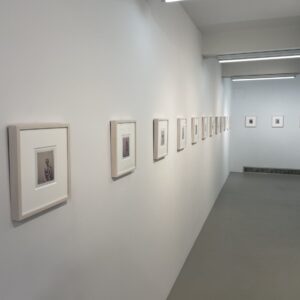JTF (just the facts): A total of 10 unique pieces, floating in white frames, and exhibited on the western wall as well as the four walls in the back room of the gallery. All are gelatin silver prints that have been altered by tearing. Nine of the 10 have been stitched together with silicone caulking, 8 of the 10 are colored with spray paint. Half are toned. The works are dated between 1977 and 1983. Sizes range from 15×17 to 35×25 inches. (Installation shots below.)
Comments/Context: Thomas Barrow (b. 1938) earned a place long ago in the annals of art photography. Almost every American survey written in the last 40 years has reproduced examples of his unconventional work, usually something from Cancellations—his series (1973-81) of nondescript or ugly Southwestern landscape views that he marked with an aggressive, corner-to-corner X. His resume is as varied as it noteworthy. A student of Aaron Siskind and Arthur Siegel at the Institute of Design in Chicago, he was in the first crop of young artists represented by Light Gallery on its opening in 1971. Following a turn as a curator at the George Eastman House, he began to teach at the University of New Mexico, where he helped to enhance its reputation as a hub of photographic experimentation. In the ’80s and ’90s, he served as director of the UNM Art Museum. Among the books he has co-edited or co-authored is Photography in New Mexico, published in 2008.
This decade has seen a resurgence of interest in Barrow’s work in New York after years of relative neglect. In 2012 Powerhouse reprinted Cancellations in a handsome duotone edition, with an introduction by Geoffrey Batchen. The next year the Derek Eller Gallery gave him a mini-retrospective, 24 pieces from 1974-2010, and followed this up in 2015 with Stylistic Drift, a group of his spray-painted photograms from 1977-89.
In everything he makes, Barrow has said that he aims to “move from the transparent, window-on-the-world form that has been photography’s primary reason for being since its invention, to making it a physical object, an object to be looked at for its own presence and not for a surrogate experience”
Modest Structures: Caulked Reconstructions, 1977-1983, his third show at the gallery, is recognizably part of this aesthetic program. None of the 10 pieces here are monumental; although fully-realized, they are more like studies than final statements. Most are spray-painted in garish tones of red, yellow, or avocado. In some cases the paint has interacted unpredictably with chemicals in the caulking, darkening the seams.
The actions Barrow takes to alter his photographs lend themselves to multiple readings. The scrawled Xs on the Cancellations series can be seen as an extreme version of New Topographics—a less neutral and more forceful expression of cynical despair over what Americans have done to the land they inherited (bought or stole.) His “technique”—using an ice-pick to score the negative—was construed at the time as an attack on the professionalism of Ansel Adams, a shock-the-audience, punk-rock act of darkroom vandalism. The spray-paint that Barrow often applies to his prints is a further expression of solidarity with the subversion of graffiti art.
Those who have interpreted the X as Barrow’s rejection of the art market, however, have to account for the fact that he has scratched the negative (not the print) and can make as many copies as he wishes. It wouldn’t surprise me if this were his best-selling series. As on a pirate map, X marks the treasured spot of his career.
Like spray-paint, caulk is another material with which to alter and remake the photographic process. Jackson Pollock undermined the traditional tools of his guild by using aluminum house paint. Barrow has done him one better by adopting an even humbler product from the hardware store. Silicone paste is applied in houses to fill in cracks, and as a cement, often for tile in the lowly bathroom. It’s a stop-gap method of repair, something called for to prevent a problem from growing worse.
It’s not clear in the series if Barrow is metaphorically trying to fix the damaged American landscape or just making another kind of funky collage. Or both. After all, he alone has ripped apart these photographs. They are willful acts, not accidents of framing. What must have excited him is that these torn edges offer opportunities for constructing new landscape views. The pieces when outlined in caulk break up the picture into smaller pictures, with irregular frames, like the leading in a stained-glass window or the black contours inside a Rouault painting,
The most successful pieces here are able to integrate the innocence of looking through a window with the more violent, centrifugal forces breaking it apart. Albuquerque Average View (1981) and f/t/s Modest Structures – Nr. Gallup (1981) and Mine Cloud Variant (1981) are like landscapes seen through a shattered windshield. To make sure, we remains aware these are merely photographs, he gives us two of them, mounted atop each other, torn in different places to create different interstices. In one instance, he has stenciled the word VIEW into the sandy tracks of a road at the base of the bottom print.
The spray-painted landscapes are on the whole less legible and crustier, with the exception of From the Seasons: Summer (1981-82), an airy collage of houseplants hanging in a window and the most unabashedly lyrical piece in the show.
Were these works not so modest in scale, they wouldn’t look out of place alongside David Hockney’s Polaroid landscapes or Letha Wilson’s cement-embedded photo sculptures or Andy Warhol’s sewn photographs. Derek Eller has done the art world a favor by reminding us what Barrow did a long time ago. He deserves his revival.
Collector’s POV: The works in the show are priced between $8000 and $9500. Barrow’s work has very little secondary market history, so gallery retail likely remains the best option for those collectors interested in following up.














